Vendee Globe: History of North American Skippers
Published on October 26th, 2016
The eighth Vendée Globe, which begins November 6 from Les Sables d’Olonn, France, is the only non-stop solo round the world race without assistance. For the 29 skippers and their IMOCA 60s, the history of the race is their guide – a guide with chapters from North America:
Since the Vendée Globe was created in 1989, five North American sailors have set sail from Les Sables d’Olonne – three from the United States (Mike Plant, Bruce Schwab, Rich Wilson) and two from Canada (Gerry Roufs, Derek Hatfield).
Some were involved in some of the most dramatic moments in the history of the Vendée Globe, while others have really enjoyed themselves and won over the public. In this eighth edition, the United States will be represented by Rich Wilson and Conrad Colman, who has dual NZ/US nationality.
We’re in Les Sables d’Olonne, and it’s the 26th of November 1989. Thirteen skippers, thirteen pioneers set sail in the first Vendée Globe, the non-stop solo round the world race, with American Mike Plant among those registered. Plant was looking to parlay the success from his first solo race – the 1986-1987 BOC Challenge, the round the world race with stopovers – in which he won Class II aboard his 50-foot boat.
In the Vendée Globe, Mike Plant finished the race but was disqualified after receiving assistance on Campbell Island (New Zealand). While moored up in a bay, his 60-foot boat Duracell dragged her anchor. As his monohull risked being washed onto the shore, he was helped by a team of scientists. The Vendée Globe rules are clear. No external assistance is allowed and so Mike Plant was automatically disqualified.
In 1991, Mike Plant finished fourth in his second BOC Challenge, aboard the monohull he sailed in his first Vendée Globe. He then built a new 60-foot boat, Coyote, to take part in the 1992-1993 edition of the Vendée Globe. On the 16th of October 1992, he left New York to head for Les Sables d’Olonne for the start of the race.
Eleven days later, Plant triggered his distress beacon. Unfortunately the search that was undertaken was in vain. A cruel twist of fate, the hull of his Coyote was found upturned and empty to the north of the Azores on November 29, the very day the second Vendée Globe began.
In the 1996-1997 Vendée Globe, the sailor from Quebec, Gerry Roufs represented North America. Winner of the transatlantic race from Plymouth in 1996, he could set off with high ambitions.
In the Southern Ocean, the competitors in the third Vendée Globe suffered in horrendous winds and mountainous seas. Raphaël Dinelli, Thierry Dubois, and the English sailor Tony Bullimore capsized, but they were all fortunately rescued. But in Paris, at Race HQ, they noticed that Gerry Roufs, then in second place, was not answering their calls.
In his last radio message, Roufs had declared, “The waves are no longer mere waves. They are as high as the Alps.” A lot of effort went into searching around the last known position of Gerry Roufs. Cargo vessels changed course, while four other competitors swept up and down the area. But the severe storm made this task very difficult and the search operation had to be interrupted.
The wreck of Gerry Roufs’s boat would only be found six months later off the coast of Chile. Winner of that very tricky race, Christophe Auguin would put it very neatly. “The big adventure that is the Vendée Globe cannot risk the lives of those involved to become one of the greatest showcases of sporting values.” His wish was fulfilled. Since the loss of Gerry Roufs, no other sailor has lost his life in the Vendée Globe.
We had to wait until 2004 to see another entrant from North America, the Californian Bruce Schwab. In 2001, he had finished in fifth place in Around Alone, the solo round the world race with stopovers. Schwab took part aboard an amazing boat that he designed with the means at his disposal. He turned up in Les Sables d’Olonne without any inferiority complex and was quite simply thrilled to be alongside the leading French and British sailors taking part in the 2004-2005 race.
Schwab finished in ninth place after 109 days at sea and in so doing, became the first American to add his name to the list of those who had completed the Vendée Globe. “You have to be a little bit crazy to do what we do, when we sail alone around the world,” he declared. “But I’m still astonished that I’m the only American sailing on an American boat to be involved in the international 60-foot circuit. I just hope that that will change soon.”
For the first time, two competitors from North America took part in the Vendée Globe in the 2008-2009 edition. The American, Rich Wilson was the oldest competitor in the race at the age of 58. With two degrees from Harvard and in applied sciences from the prestigious MIT in Boston, Rich Wilson knew how to share his experience during this adventure.
He had been using sailing as a teaching aid since 1990 when he attempted to smash the record between San Francisco and Boston. His various challenges were followed by thousands of children in the United States. Using adventure to encourage learning really worked and he would continue to do that with his biggest challenge, the Vendée Globe.
On an old monohull that was ten years old, he overcame the gales and the various damage he suffered. He finished in Les Sables d’Olonne in ninth place after 121 days at sea, and was particularly happy to have been able to have experienced and shared this Vendée Globe with so many people.
The outcome was different for Derek Hatfield, the second Canadian to set sail in the Vendée Globe, twelve years after Gerry Roufs. On the day after the start, he had to turn back to repair his wind turbine and his mast track, part of which had snapped off. Derek Hatfield set off again from Les Sables five days after the others and continued to race until the Southern Ocean.
Caught in a violent storm, Hatfield capsized to the south of Australia and broke two spreaders. His boat righted herself, but the rig was so badly affected that he was unable to continue to race. Derek Hatfield headed for Hobart (Tasmania) under reduced sail and retired from the race. He was not going to be the first Canadian to complete the Vendée Globe. We recently had the sad news that he had passed away at the age of 63.
So what about the 2016-17 edition of the Vendée Globe? Among the 29 skippers there will be one sailor with dual nationality (American and New Zealand). We are talking about Conrad Colman, who will be competing in his first Vendée Globe, after completing two double-handed round the world trips (the Global Ocean Race on a Class40 and the Barcelona World Race on an IMOCA).
On 6th November, another American sailor will set sail from Les Sables, a certain Rich Wilson. As in 2008-2009, he will be the oldest competitor in the race taking part aboard a boat that was almost ten years old: Great American IV, an Owen Clarke design from 2006. This boat clearly has the potential for him to improve on the time he set in 2008-2009.
Looking beyond the race result, Wilson is eager to develop his educational programmes, in order to pass on positive values to young people in the States and around the world. “We want to come up with all the content planned for schools: a daily radio link-up and log, weekly tests for our teaching programme, photos, videos, weekly replies to the questions raised by students, biometrical data.”
Just like Schwab in the past, Wilson also hopes that by taking part the Vendée Globe will become better known in the United States, leading to more competitors taking part in future races, which are bound to be as exciting as those we have already witnessed.
North American competitors – facts and figures
• 5 sailors have set off: Mike Plant (USA), Gerry Roufs (Canada), Bruce Schwab (USA), Rich Wilson (USA) and Derek Hatfield (Canada)
• 2 sailors lost: Mike Plant (in 1992, during his delivery trip from New York to Les Sables d’Olonne) and Gerry Roufs (in 1997)
• 2 have completed the race: Bruce Schwab (9th in 2004-2005) and Rich Wilson (9th in 2008-2009)
• 1 made it all the way around but was disqualified: Mike Plant (in 1989-1990)
• 1 retired: Derek Hatfield (in 2008-2009)
• Best time: Bruce Schwab with a time of 109 days, 19 hours and 59 minutes (in 2004-2005)
Race details – Entries – Facebook – VendeeGlobe TV
Background:
The eighth Vendée Globe, which begins November 6 from Les Sables d’Olonn, France, is the only non-stop solo round the world race without assistance. Twenty-nine skippers representing four continents and ten nations will set sail on IMOCA 60s in pursuit of the record time set by François Gabart in the 2012-13 race of 78 days, 2 hours and 16 minutes.
For the first time in the history of the event, seven skippers will set sail on IMOCA 60s fitted with foils, which allow the boat to reduce displacement for speed gains in certain conditions. It will be a test to see if the gains can topple the traditional daggerboard configuration during the long and demanding race.
Source: Vendee Globe / Olivier Bourbon / M&M


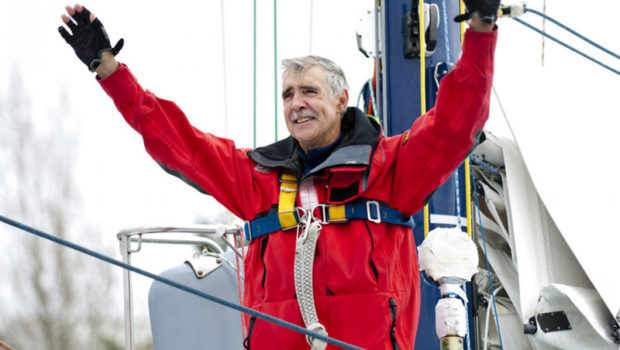

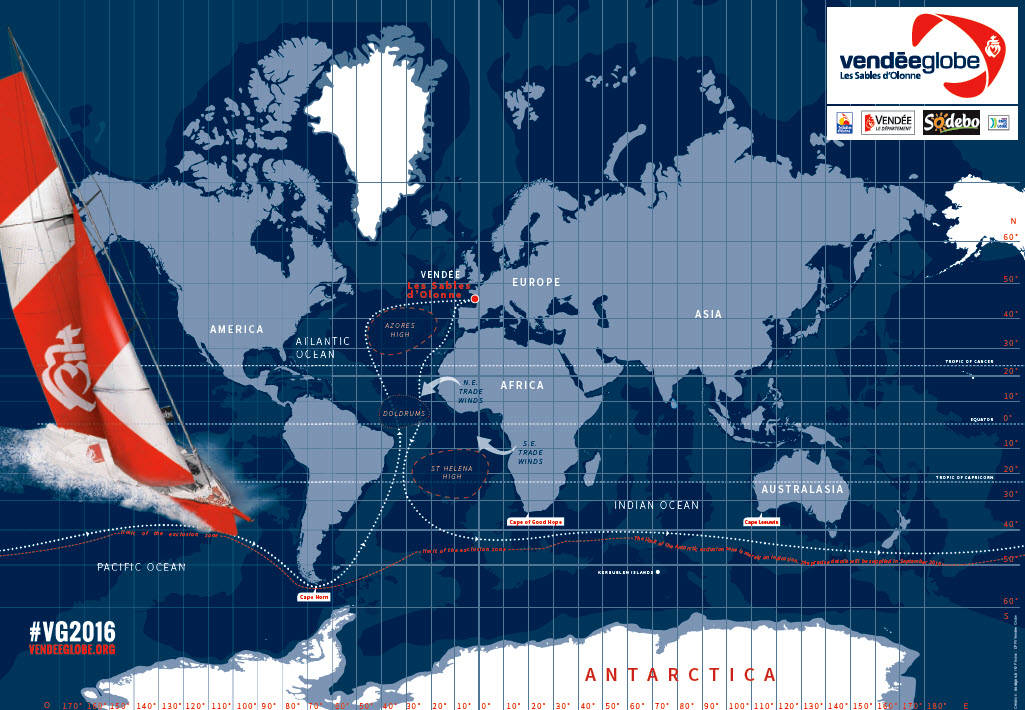

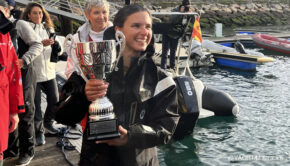
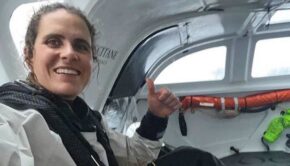
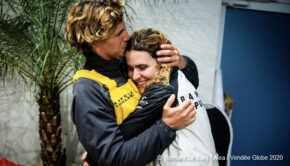
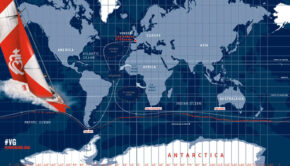
 We’ll keep your information safe.
We’ll keep your information safe.